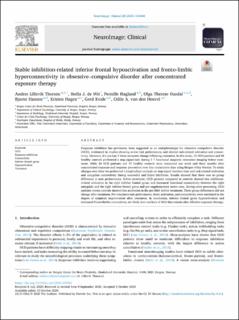| dc.contributor.author | Thorsen, Anders Lillevik | |
| dc.contributor.author | de Wit, Stella J. | |
| dc.contributor.author | Hagland, Pernille | |
| dc.contributor.author | Ousdal, Olga Therese | |
| dc.contributor.author | Hansen, Bjarne | |
| dc.contributor.author | Hagen, Kristen | |
| dc.contributor.author | Kvale, Gerd | |
| dc.contributor.author | van den Heuvel, Odile A | |
| dc.date.accessioned | 2021-06-07T12:48:16Z | |
| dc.date.available | 2021-06-07T12:48:16Z | |
| dc.date.created | 2021-01-25T12:35:11Z | |
| dc.date.issued | 2020 | |
| dc.Published | NeuroImage: Clinical. 2020, 28:102460 1-8. | |
| dc.identifier.issn | 2213-1582 | |
| dc.identifier.uri | https://hdl.handle.net/11250/2758224 | |
| dc.description.abstract | Response inhibition has previously been suggested as an endophenotype for obsessive–compulsive disorder (OCD), evidenced by studies showing worse task performance, and altered task-related activation and connectivity. However, it’s unclear if these measures change following treatment. In this study, 31 OCD patients and 28 healthy controls performed a stop signal task during 3 T functional magnetic resonance imaging before treatment, while 24 OCD patients and 17 healthy controls were rescanned one week and three months after concentrated exposure and response prevention over four consecutive days using Bergen 4-Day Format. To study changes over time we performed a longitudinal analysis on stop signal reaction time and task-related activation and amygdala connectivity during successful and failed inhibition. Results showed that there was no group difference in task performance. Before treatment, OCD patients compared to controls showed less inhibition-related activation in the right inferior frontal gyrus, and increased functional connectivity between the right amygdala and the right inferior frontal gyrus and pre-supplementary motor area. During error-processing, OCD patients versus controls showed less activation in the pre-SMA before treatment. These group differences did not change after treatment. Pre-treatment task performance, brain activation, and connectivity were unrelated to the degree of symptom improvement after treatment. In conclusion, inferior frontal gyrus hypoactivation and increased fronto-limbic connectivity are likely trait markers of OCD that remain after effective exposure therapy. | en_US |
| dc.language.iso | eng | en_US |
| dc.publisher | Elsevier | en_US |
| dc.rights | Navngivelse 4.0 Internasjonal | * |
| dc.rights.uri | http://creativecommons.org/licenses/by/4.0/deed.no | * |
| dc.title | Stable inhibition-related inferior frontal hypoactivation and fronto-limbic hyperconnectivity in obsessive–compulsive disorder after concentrated exposure therapy | en_US |
| dc.type | Journal article | en_US |
| dc.type | Peer reviewed | en_US |
| dc.description.version | publishedVersion | en_US |
| dc.rights.holder | Copyright 2020 The Authors. | en_US |
| dc.source.articlenumber | 102460 | en_US |
| cristin.ispublished | true | |
| cristin.fulltext | original | |
| cristin.qualitycode | 1 | |
| dc.identifier.doi | 10.1016/j.nicl.2020.102460 | |
| dc.identifier.cristin | 1878357 | |
| dc.source.journal | NeuroImage: Clinical | en_US |
| dc.source.40 | 28:102460 | |
| dc.identifier.citation | NeuroImage: Clinical. 2020, 28, 102460. | en_US |
| dc.source.volume | 28 | en_US |

